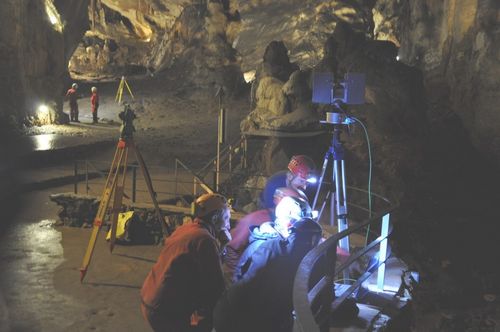2011 - 2016 The decorated caves of Gaztelu hill
Isturitz and Oxocelhaya
Research director : Diego Garate
Starting in 1913, E. Passemard inventoried some fifteen animal etchings on the central pillar of the Main Hall of
Isturitz. A new in-depth examination of the figures of this pillar, done in 1970 by I. Barandiaran and G. Laplace, authenticated six animal representations: two small deer, a reindeer, a bear, an
ibex and a horse.
In the Oxocelhaya-Hariztoya cave, the second karstic network, G. Laplace discovered parietal figures in a terminal
gallery in 1955. In 1982, J.D. Larribau identified new etchings of horses and bison in a median gallery. S. Prudhomme undertook a study of all of the parietal art of the caves of the hill in a
thesis defended in 1989.
In 1995, the Regional Archeology Service of Aquitaine undertook an operation to determine the archeological potential
of the entire Gaztelu hill, in the form of a “white paper”. This led, among other things, to the carrying out of several surveys in the Isturitz cave, under the co-direction of A. Turq and C.
Normand between 1996 and 1998 and the revision of the parietal art of Isturitz and Oxocelhaya by A. Labarge. This period of surveys led to 10 years (2000-2010) of organized excavations focusing
on the Aurignacian sequence, under the direction of C. Normand.
Given the history of the site, it seemed obviously necessary to resume the study of the parietal art, and to thereby
establish links between the dwelling site, parietal art and mobile art. In 2010, a new multi-disciplinary and cross-border team of some twenty researchers was established under the direction of
D. Garate (Conservator at the Bizkaia Museum of Archeology, in Bilbao).

Photo : Diego Garate
Various work orientations were defined based on the main objectives of
the project:
• Topographical restitution of the caves (M. Douat).
• Geomorphological characterization of the caves (N. Vanara).
• 3D restitution of the caves (J. Darricau).
• Inventory of the paleolithic parietal activities (D. Garate).
• Chemical determination of the composition of the paints (K. Castro).
• C14 dating of the parietal activities (C. Szmidt).
• Analysis of paleolithic dwellings (C. Normand).
• Analysis of the incorporated objects (M. Peyroux).
• Technological analysis of the graphic activity (R. Bourrillon).
• Plastic analysis of the graphic activity (A. Labarge).
• Stylistic analysis of the graphic activity (D. Garate).
• Geographic and chronological contextualization of the parietal activities (D. Garate, A. Labarge,
M. Peyroux, R. Bourrillon, C. Normand, O. Rivero).
These various research approaches will be developed over the next six years. They will allow us to grasp the place of
art in prehistoric societies, and also the major role of the caves of Isturitz and Oxolcehaya in the Pyrenees-Cantabria region.
This project was approved by Dany Barraud (Regional archeology conservator) and received financial support from the
Direction Régionale des Affaires Culturelles (DRAC) of Aquitaine. Joëlle Darricau, owner of the caves, and the Association Gaztelu also provided logistical and financial support for the
project.
Several organizations are thus involved in the project: Isturitz Oxocelhaya Espace Culturel Arts et Sciences,
Association Gaztelu, University of Toulouse-Le Mirail, University of Bordeaux I and the University of the Basque Country. Within the context of the integration of new technologies in archeology,
a partnership was established with the Bidart Engineering School (ESTIA).
The first campaign is currently underway
We are revising the inventory of the art that was published earlier. A detailed topography of the caves is now being
done. Also, tests are being carried out in order to best combine the application of the new technologies to the study of the site (three-dimensional restitution and photogrammetry). Therefore, in
the years to come, this work will allow us to define the detailed prospection of the walls and the in-depth studies of the art.
The initial work of this original and ambitious project has already brought us promising results. We know that they
will be further enriched in the years to come.
Saint-Martin-d’Arberoue, April 29, 2011
